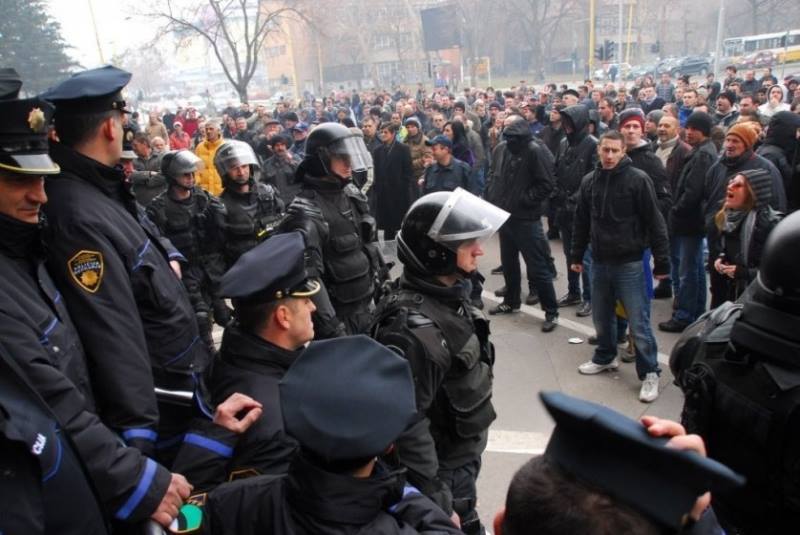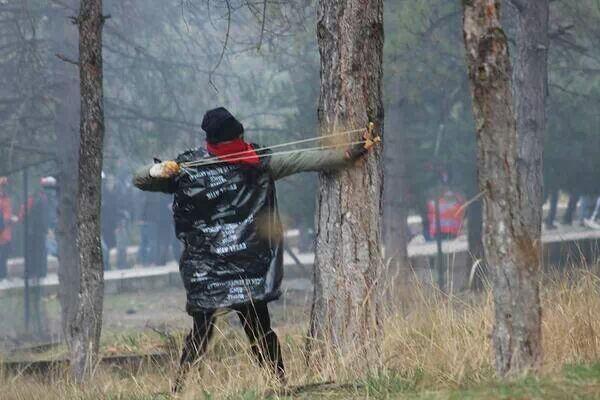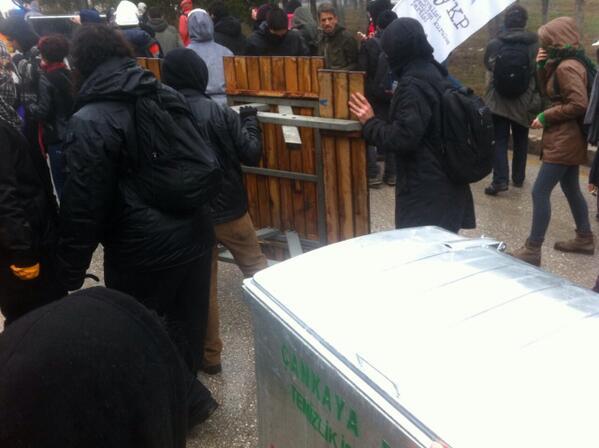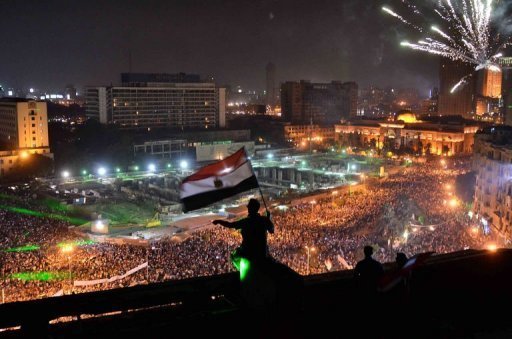Tag Archives: ΤΑΡΑΧΕΣ
Με αφορμή το ταξίδι ενός σοσιαλιστή στην Ουκρανία
These criminals don’t understand the language of peaceful protest!
Δείτε το video της συνέντευξης των εργατών του εργοστασίου Dita εδώ:
http://en.labournet.tv/video/6657/interview-dita-workers-tuzla
We are showing here an interview with the workers of the factory Dita, whose protest was a trigger to the whole movement that is sometimes referred to as the Bosnian Spring.
The workers of the detergent factory Dita told us that they had been on strike for more than a year and tried different forms of peaceful protests (including a hunger strike) that did not lead anywhere. When they demonstrated with other workers on the 5th of February, they were brutally attacked by the police. This provoked a massive movement of solidarity by younger people and unemployed, who took to the streets and stormed and burned the government building of canton Tuzla, forcing the government to resign (local authorities in Bosnia-Herzegovina are more important than national ones).
In this short video, the workers tell us about the history of their struggle as well as their grasp of the movement that is currently shaking Bosnia-Herzegovina.
Τουρκία: Ταραχές για όλους τους λόγους (λογοκρισία, διαφθορά, περιβάλλον)
Ταραχές ενάντια στη λογοκρισία που προσπαθούν να επιβάλλουν στο ιντερνετ:
[youtube]https://www.youtube.com/watch?v=arVWfxv8mjE[/youtube]
Φοιτητές συγκρούστηκαν με την αστυνομία στη διαδήλωση ενάντια στην κατασκευή αυτοκινητόδρομου στην περιφέρεια της Άγκυρας:
Ταραχές παντού και για τη “διαφθορά του Ερντογάν” (πηγή revolution news):
A leaked recording surfaced of Turkish PM Erdogan Instructing his son to hide huge sums of money. In the new voice recording, Erdoğan and his son Bilal allegedly discuss during five wiretapped phone conversations on plans how to hide huge sums of cash on the day when police raided a number of venues as part of a corruption investigation that has implicated sons ofthree Turkish ministers, businessmen and chief of the state bank. At the beginning of the phone conversation, the prime minister briefs his son Bilal about the raid and asks him to “zero” the amount (at least $1 billion cash) stashed at five houses. The authenticity of the recordings has not been verified.
Tonight citizens of Turkey have taken the streets of Istanbul, Ankara, Sakarya,Bursa, Antalya, Izmir, Kartal and others to vent frustration and disapproval over Erdogan’s corruptive practices.
Dead End: About the Coup in Egypt
Παρά το σαφή εργατίστικο προσανατολισμό της ανάλυσης του Wildcat αναδημοσιεύουμε το άρθρο γιατί θεωρούμε ότι φωτίζει με ικανοποιητικό τρόπο τα αποτελέσματα αλλά και τις εσωτερικές αντιφάσεις της πολιτικοποίησης των ταραχών στην Αίγυπτο.
W.
πηγή: http://www.wildcat-www.de/en/eindex.htm
Go to the Afterword from February 2014
For two years, Tahrir Square was the symbol of a radical departure from social ossification and crisis. The military coup in the summer of 2013 ended this phase. The various illusions and hopes were buried with the hundreds that died. Essential parts of the liberal milieus have accepted state-led massacres and mass arrests in the name of ‘defending democracy’. The hope of a state solution to social misery is also lost; the last heirs of Nasserism and trade union movement-hopefuls now sit at the military (side) table. Their vague promises of reform are drowned out by their appeals to peace, order and willingness to work.
In the acute social situation there is currently no room for participation. The movement will have to provide new questions about social revolution and organisation and will have to find new answers. To this end, migrants play an important role.
Egypt’s ruling class
With the fall of President Morsi at the beginning of July 2013, the amalgamation of the state and military apparatus with the economy once again became visible. This form of class power emerged at the end of the Nasser era. In the mid-seventies, the military had lost its role as protectors of an ‘anti-colonial’ state industrialisation, and the bloated military apparatus afterwards found itself new fields of activity in the civil economy after the 1978 peace treaty with Israel. A new model of accumulation developed, particularly during the second, ‘neoliberal’ half of the 30-year long Mubarak regime, which was less based on industrialisation, and more on privatisation, the plundering of social wealth and on state-secured investments in infrastructure (transport, tourism, telecommunications). This model was enforced by a gigantic repressive apparatus, which was detached from any ‘democratic control’. This apparatus included an informal army of baltagiyyas (thugs) and the military courts, which had been installed permanently since the state of emergency in 1981. The uprising in 2011 showed the crisis of this model.
It is still the case that most of the companies are small and medium-sized enterprises, but they are controlled by a very small layer of society through an old boys network, which means that we are dealing with monopolies. In 2010, around 500 families owned financial assets of more than 30 million USD, while 20 families (the ‘core-elite’) owned more than 100 million. The main economic focus of these groups of enterprises is on construction, telecommunications, tourism, food and pharmaceutical production, and (foreign) trade. At the very top stands the Sawiris family, which owns Egypt’s largest construction company and rules over the telecommunications market and the media sector. In the 2000s this new economic elite took over the high command of political power directly; prime examples being Gamal Mubarak and the Nazif government, which came to power in 2004. Politically, they thereby entered into competition with the military apparatus, which manages the factories of the Nasser-ite epoch of industrialisation (consumption goods and arms manufacturing) and which, in addition, started to participate in the business of mass tourism since its boom in the 1990s. In total the military controls 5 to 15 per cent of the national economy.
The military played a significant role in the enforcement of this neoliberal looting because it has the right to confiscate land e.g. for the construction of infrastructure projects, tourist parks, and new industrial zones. This was the cohesive element between the military and the oligarchic elite. The top-layer of the Muslim Brotherhood, which mainly engaged in trade, were part of this arrangement, although, apart from a few exceptions, they were situated rather in the second or third tier. The military and civil top elite is partly Coptic (like the Sawiris) and in general rather secular.
The network of clientelism that was directed towards the masses was organised in ‘religious’ terms. After the privatisation in the 90s, the welfare system (benefits for the poor, education and health care) was split off into a completely deficient and corrupt public sector, an expensive private sector and a third sector comprising the various liberal, islamist and christian charities. The vast NGO sector is based on voluntary and informal labour and, in part, directly organises the informal economic sector.
Anarchists in the Bosnian Uprising: Two Interviews
Freedom is my nation
πηγή: http://www.crimethinc.com/index.html
The past two weeks have seen a fierce new protest movement in Bosnia, commencing with the destruction of government buildings and continuing with the establishment of popular assemblies. Unlike the recent conflicts in Ukraine, this movement has eschewed nationalistic strife to focus on class issues. In a region infamous for ethnic bloodshed, this offers a more promising direction for the Eastern European uprisings to come.
To gain more insight into the protests, we conducted two interviews. The first is with a participant in Mostar, Bosnia, who describes the events firsthand. The second is with a comrade in a nearby part of the Balkans, who explains the larger context of the movement, evaluating its potential to spread to other parts of the region and to challenge capitalism and the state.
Interview with a Participant
Give us a brief timeline of the important events.
On Wednesday, February 5, workers from several local companies that were destroyed by post-war privatization organized another protest in front of the Cantonal Government Building in Tuzla. Those workers have been protesting peacefully for a decade, organizing strikes and hunger strikes—which were very common in Bosnia until this month—but nobody listened. For just about the first time in post-war Bosnia, young people organized over social networks to express solidarity with desperate workers. Almost 10,000 people supported their protest on Thursday, February 6; that was when the first clashes with the police happened, and the first attempt to enter the government building.
Tuzla, February 5, 2014
On Friday, February 7, more than 10,000 people gathered in the post-industrial city of Tuzla in front of the Cantonal Government building, asking for the Prime Minister’s resignation. The Prime Minister arrogantly refused to resign. None of the officials came out to speak to them, so people broke through the police lines, entered the building, and burned it down.
On the same day, solidarity protests with the workers of Tuzla were organized in almost all the industrial towns of Bosnia. News from Tuzla spread fast; people in Bihać, Sarajevo, Zenica, and Mostar felt that this could be a moment to try to win a change. After the police attacked protesters in Sarajevo, during which some of the people were pushed down and thrown into the river Miljacka, the crowd fought back, forcing back the police and burning down the building of the Cantonal Government, as well as the buildings of the Presidency (including the state flag), the municipality of Sarajevo Center, and several police cars and vans. In Bihać, people attacked the building of the Cantonal Government and smashed it up. The same thing happened in Zenica.
Everyone was anticipating the events in the ethnically divided city of Mostar. More than 4000 people gathered in front of the Cantonal Government, demanding resignations. Soon, the first rocks were thrown, to great applause. From that moment, more and more people were putting t-shirts, balaclavas, masks—whatever they could find—over their faces; without any police resistance, within a few minutes, the building was on fire. Then people went to the City Hall and burned it down, as well as the building of the cantonal Parliament, Mostar Municipality, and the offices of two leading nationalist political parties that have ruled this city since 1991. That made quite a statement.
Protests are still going on, and people have organized themselves in plenums [assemblies]. Four cantonal governments have been forced to resign. Two of them are negotiating with plenums about forming governments of people who are not active members of any political parties. The authorities are fighting back hard—spreading fear of another civil war, arresting people, beating them, pressing charges for terrorism and attack on constitutional order…
Tuzla, February 7, 2014
Who participated? How and why did the protests spread? What limits did they reach?
The participants were from all social groups. Workers, unemployed, pensioners, many young people, demobilized soldiers, activists, football fans, human rights activists, parents with their children…
The people of Bosnia and Herzegovina are the poorest in Europe. Unemployment is over 50%; among young people, it is over 70%. At same time, Bosnian politicians are among the best paid in southeast Europe, and the most corrupt. The healthcare system is the worst in Europe, and social safety nets are almost nonexistent. The society that was one of the most egalitarian in Europe 25 years ago now has a huge social gap.
Capitalism and the process of privatization have completely destroyed the local economy; all the big factories and companies that were saved during the war have been privatized and shut down. All the wealth is concentrated in the hands of a few. There is no production in Bosnia any more, only import. The authorities are taking bigger and bigger loans from the IMF, knowing that they have no way of paying them back—so we can expect to be forced to privatize Bosnian Telecom and Electro-energetic system, the last viable pubic companies.
Ναντ: Ταραχές ενάντια στην κατασκευή του αεροδρομίου
[youtube]https://www.youtube.com/watch?v=eIgNvAHIVmw[/youtube]
Protesters opposed to plans to build a new airport for the French city of Nantes smashed shop windows Saturday and hurled paving stones at police, who answered with tear gas and rubber bullets.
Tens of thousands of protesters against building the airport on protected swampland swarmed the western city’s Petite Hollande square, the latest in a string of demonstrations against the pet project of Prime Minister Jean-Marc Ayrault.
But a short distance away, about 1,000 radical environmentalists staged a more violent protest, smashing shop windows and trashing a post office and the local offices of Vinci, the contractor on the airport project in nearby Notre-Dame-des-Landes.
The eco-warriors pulled up paving stones from the Nantes tramway and threw them at charging police, along with bottles, emergency flares and other projectiles.
Six police were wounded in the clashes and four protesters were arrested, officials said.
The protest comes two months after local officials gave the final go-ahead for preliminary work on the 580-million-euro ($795-million) project, which was approved in 2008.
Construction is due to start this year but has not yet begun, and the target date for opening has been pushed back from 2017 to at least 2019.
The airport is set to have an initial annual capacity of four million passengers.
Ουκρανία: Το Μεϊντάν και οι αντιφάσεις του. Συνέντευξη με έναν επαναστάτη συνδικαλιστή
For weeks and weeks, we have been looking at Ukrainian events, trying to make sense of what has been happening in Kyiv and other cities. We had read many texts, comments and interviews and discussed about Maidan, but we had been always arriving only at new questions to be answered. Thus, when a possibility occurred to get in touch with Ukrainian comrades one of us tried to use it as best as he could. As a result of that effort and thanks to kindness and patience of Denis from a Kyiv branch of a revolutionary syndicalist group called Autonomous Workers Union the following interview came into existence. Hopefully, it will provide you with many useful insights into the Maidan movement and its context. Continue reading
Ουκρανία: Μια ερασιτεχνική έρευνα για τη σύνθεση των εξεγερμένων
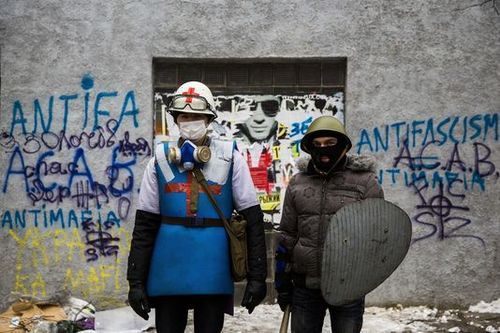
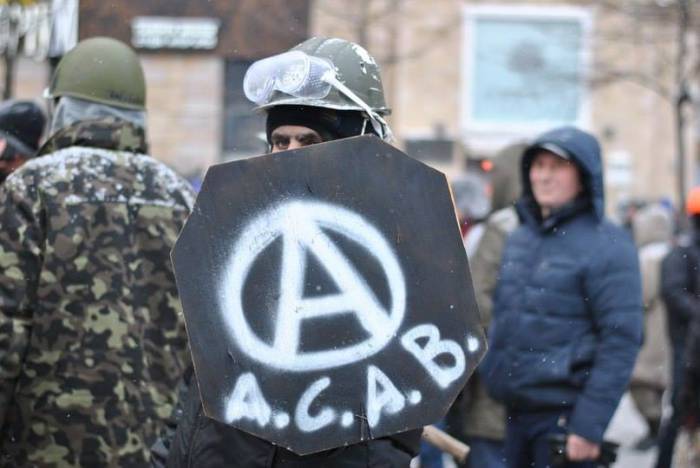
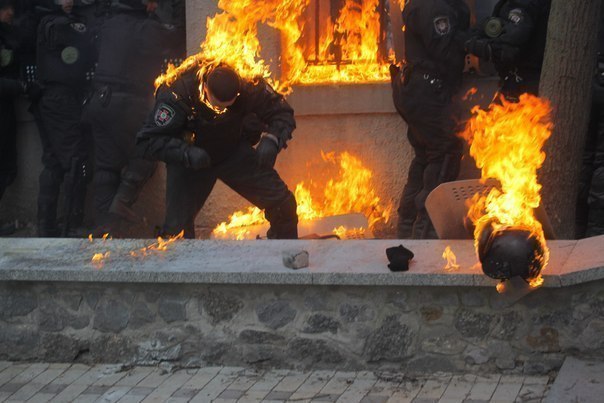 Αναδημοσιεύουμε από εδώ μια «έρευνα» σχετικά με το ποια είναι, γιατί εξεγείρονται και τι θέλουν τα άτομα που λαμβάνουν μέρος στις συγκρούσεις με τις δυνάμεις καταστολής στο Κίεβο. Αν και ερασιτεχνική, η «έρευνα» αυτή είναι ενδεικτική της σύνθεσης του κόσμου που συμμετέχει ενεργά στην εξέγερση.
Αναδημοσιεύουμε από εδώ μια «έρευνα» σχετικά με το ποια είναι, γιατί εξεγείρονται και τι θέλουν τα άτομα που λαμβάνουν μέρος στις συγκρούσεις με τις δυνάμεις καταστολής στο Κίεβο. Αν και ερασιτεχνική, η «έρευνα» αυτή είναι ενδεικτική της σύνθεσης του κόσμου που συμμετέχει ενεργά στην εξέγερση.
A Sociological Survey With the Purpose of Finding Out Which Social Layers Are the Militant Force of the Modern Revolution in Ukraine?
Introduction
Our assumption has been that in Ukraine we have a revolution combined with counter-revolution. The counterrevolutionaries are the 3 pseudo-leaders – Oleh Tyahnibok of “Svoboda”, Vitaly Kitcko of “Udar” and Arseniy Yatsenuk of “Bat�kivschina”. They struggle with the government of Yanukovich and the Party of Regions for redistribution of the state power, and, hence, redistribution of the former state property (for, you see, in Ukraine and other similar “transitional states”, possession of state power opens the door to grabbing of the state property!). Revolutionaries are those who do not belong to any party, who are by themselves at the barricades and who fight the cops. The official “opposition” and “Maidan” (Maidan refers to the main square in Kiev, Ukraine, where in the winter of 2013-14 there are major anti-government protests and clashes with the police) are two different and even contradictory concepts.
We’re faced with the question: who is the moving force of the revolution in Ukraine today? Who is really manning the barricades and performs other militant functions on the Maidan? To answer these questions we have conducted a sociological survey. We have questioned those who were manning the barricades at the entrance to Maidan from the direction of TsUM (the Central Universal Store, which used to be the main department store in Kiev, located on the main street of the city, Khreschatik). We have surveyed the militants along the Maidan, the guards at the entrance to the Ukrainian House (taken over by the rebels), and especially at the barricades on the Hrushevskogo Street (which was the epicenter of clashes). In the course of one day, 15 February, 2014, we have managed to survey 37 people, while some of the participants have given an extended oral interview, for which I am grateful to them.
We have formulated questions about the education and professional background of the participants. Then we’ve asked the questions about their vision of the situation in Ukraine and what is to be done about it. To be more concrete, we’ve formulated the following 5 questions:
1. Education: 1) didn’t finish school, 2) finished high school, 3) technical 2-year college, 4) incomplete higher education, 5) higher education.
2. What did you do before the Maidan? (type of activity, profession, how did you make a living)
3. What will you do after the Maidan? (What would you like to do? What will you do realistically?)
4. How do you understand the main problems now facing Ukraine? (The main problems of the society).
5. How can these problems be solved? (The ideal final result. The innermost desire for the future of this society). Continue reading
2 Κείμενα απ’ το Κίεβο
αναδημοσίευση από ruthless critique against everything existing
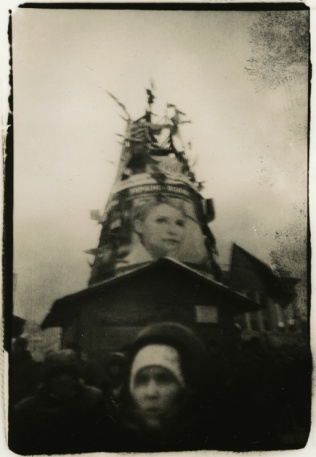 Στο κέντρο του Μαϊντάν, τις πρώτες μέρες φιγουράριζε και το πορτρέτο της φυλακισμένης πρώην προέδρου της χώρας Τιμοσένκο.
Στο κέντρο του Μαϊντάν, τις πρώτες μέρες φιγουράριζε και το πορτρέτο της φυλακισμένης πρώην προέδρου της χώρας Τιμοσένκο.
Μια μικρή εισαγωγή
Η κατάσταση στο Κίεβο είναι σίγουρα αντιφατική και θολή, όπως κάθε κοινωνική σύγκρουση. Σε καμία ιστορική εποχή-ούτε καν οι τιμημένοι, για κάποιους μπολσεβίκοι ή ο Μαχνό για άλλους- δεν υπήρξε κίνημα χωρίς αντιφάσεις και πισωγυρίσματα, πόσο μάλλον στον καιρό της δημοκρατίας και του κεφαλαίου, που τα πάντα είναι δεμένα σε ένα αντιφατικό όλο. Όποιος ψάχνει “καθαρές” επαναστάσεις έχει πολύ ψάξιμο ακόμα. Η σύγκριση διαφόρων εξεγέρσεων ως καλύτερων ή χειρότερων, προσπερνά στα τυφλά το ευμετάβλητο των κοινωνικών κριτηρίων ως αποτύπωση των ίδιων ανταγωνισμών, που υποτίθεται πως κρίνει, ενώ αγνοεί τα γεγονότα ως διαλεκτικό αποτέλεσμα προηγούμενων αντιφάσεων. Συνεπώς η σύγκριση μεταξύ Βοσνίας και Κιέβου, είναι άστοχη, και κυρίως πολιτική, πέρα από τις ιδιαίτερες συνθήκες που γέννησαν τα γεγονότα, είναι κριτικές της μορφής. Στο πλαίσιο αυτό οφείλουμε να δούμε τα γεγονότα, όχι ως πολιτικά αντίθετα που συγκρούονται. αλλά ως αντιφατικές ενότητες σε αποσταθεροποίηση.. Αυτό που κάνουμε-που προσπαθούμε να κάνουμε- είναι να δούμε με ποιον αντιφατικό τρόπο τα υποκείμενα της καπιταλιστικής ολότητας προσπαθούν να επιλύσουν και να ξεφύγουν από την ίδια τους την πραγματικότητα και ουσιαστικά από τον ίδιο τους τον εαυτό, τι διακυβεύματα και όρια βάζουν στον εαυτό τους .Σε τελική ανάλυση η καπιταλιστική-και όχι η οικονομική απλά- κρίση σε ποιό βαθμό είναι αδυναμία αναπαραγωγής της αξίας και σε ποιό βαθμό η διαδικασία επαναφοράς της; Με λίγα λόγια δεν θέλουμε να δικαιολογήσουμε την Ουκρανία ή να υποτιμήσουμε τη Βοσνία(ή το αντίστροφο). Κοιτούμε κριτικά τις μορφές που παίρνει η ταξική πάλη σε κάθε χώρα, ως αντιφάσεις του ίδιου τους του εαυτού


